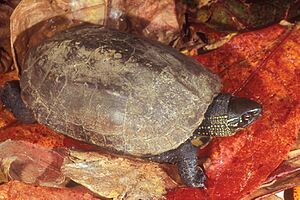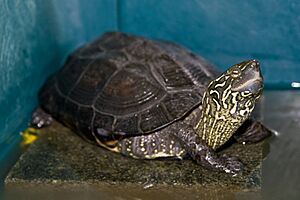Chinese pond turtle facts for kids
Quick facts for kids Chinese pond turtle |
|
|---|---|
 |
|
| Mauremys reevesii in East Timor | |
| Conservation status | |
| Scientific classification | |
| Genus: |
Mauremys
|
| Species: |
reevesii
|
The Chinese pond turtle, also called the Chinese three-keeled pond turtle or Reeves' turtle, is a type of turtle. It belongs to the family Geoemydidae. This turtle is originally from East Asia.
Long ago, people used the shells of these turtles for divination, which was a way to try and predict the future. Scientists have found many of their shells at old sites from the Shang dynasty in China.
Contents
Where Chinese Pond Turtles Live
The Chinese pond turtle is naturally found in China and Korea. People believe it was brought to Japan and Taiwan a long time ago. For example, it might have arrived in Japan from Korea around the late 1700s.
When these turtles are introduced to new places, they can sometimes cause problems for the turtles that naturally live there. This is because they can sometimes breed with other turtle species.
What They Like and How They Act
These turtles are semiaquatic, meaning they live partly in water and partly on land. They enjoy warming up in the sun on rocks or logs. You can often see them leaving the water to do this.
They usually live in wet areas like marshes, shallow ponds, streams, and canals. They prefer places with muddy or sandy bottoms.
Why They Need Our Help
The Chinese three-keeled pond turtle is an endangered species. This means it is at risk of disappearing forever. Several things threaten them:
- They face competition from pet red-eared sliders that have been released into the wild.
- They are hunted too much because their bottom shell, called a plastron, is used in traditional Chinese medicine.
- They are also caught to be sold as pets.
- Their natural homes are being destroyed.
Even though they are endangered, these turtles can breed well when cared for by humans.
Naming the Turtle
The scientific name for this turtle is reevesii. It was named after an English naturalist, John Reeves. A naturalist is someone who studies nature.
Turtle Hybrids
The Chinese pond turtle is known for being able to create hybrids. A hybrid is an animal that has parents from two different species. These turtles can even breed with other turtle species that are not very closely related.
For example, a supposed new turtle species was actually a hybrid between a male Chinese pond turtle and a female yellow pond turtle. They have also created hybrids with other turtles like the Chinese stripe-necked turtle and the Japanese pond turtle when kept in captivity.
This ability to hybridize can be a problem for native turtle populations. If you have a Chinese pond turtle as a pet, it's very important to keep it separate from other types of turtles. This helps protect other species.
Farming Chinese Pond Turtles
Today, Chinese pond turtles are raised on special farms in China. This is because there is a high demand for them. Their shells are used in traditional medicine, and they are also sold as pets.
In 2002, a survey of many Chinese turtle farms found that millions of these turtles were being raised. Farmers sold hundreds of thousands of them each year. The value of these farmed turtles was millions of US dollars.
Keeping Them as Pets
Chinese pond turtles are also raised for the pet trade. If you have one as a pet, they need similar care to red-eared sliders.
Chinese Pond Turtles in East Timor
A small group of Chinese pond turtles has been found living in marshes in East Timor. These turtles are not native to the island. They were likely brought there by people of Chinese origin.
East Timor has its own native turtles, like the Roti Island snake-necked turtle. While the introduced Chinese pond turtles are not known to directly harm the native ones, there could be problems if people confuse them. Sometimes, the introduced Chinese pond turtles are caught and sold. If this practice spreads to native turtles, it could be a problem. One idea to help is to remove the introduced Chinese pond turtles from the wild.
Images for kids





